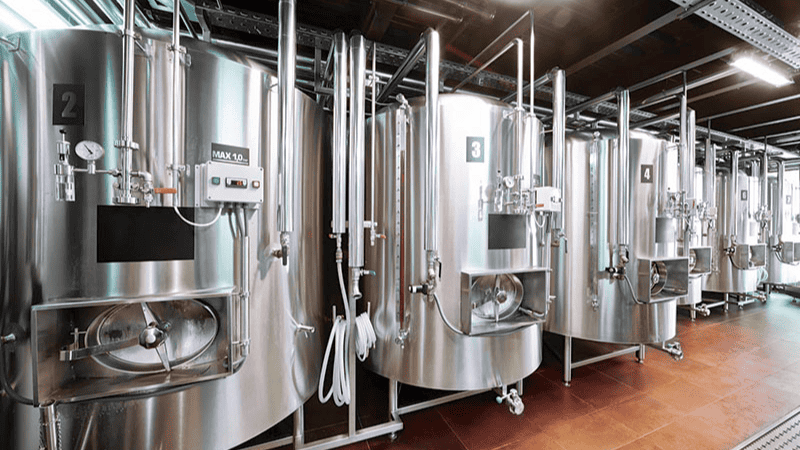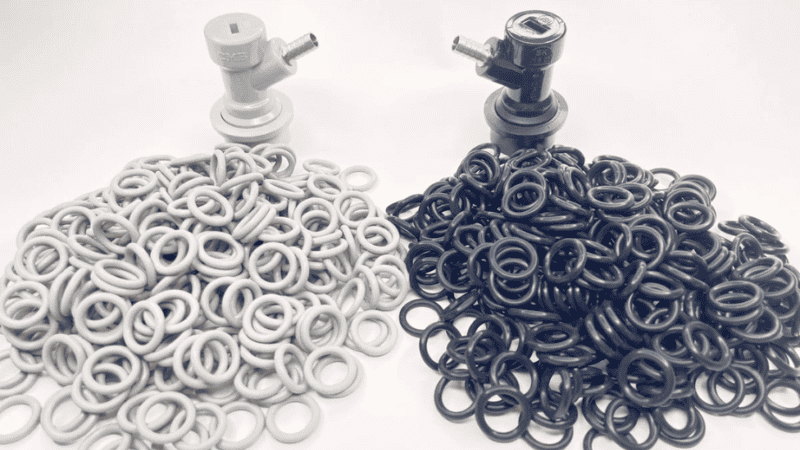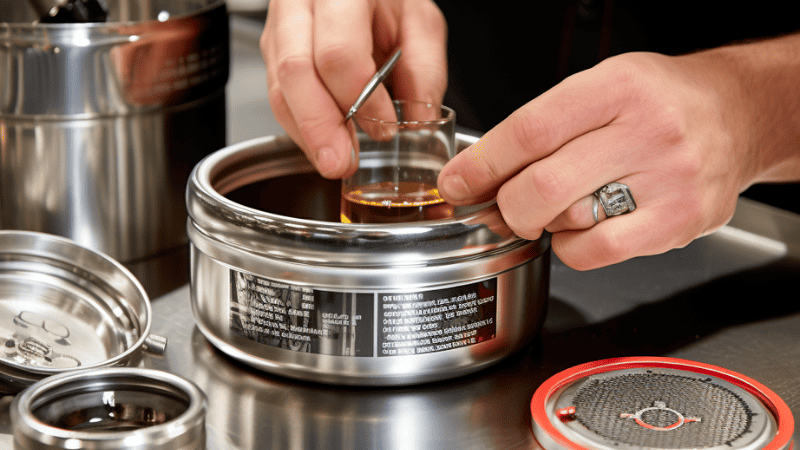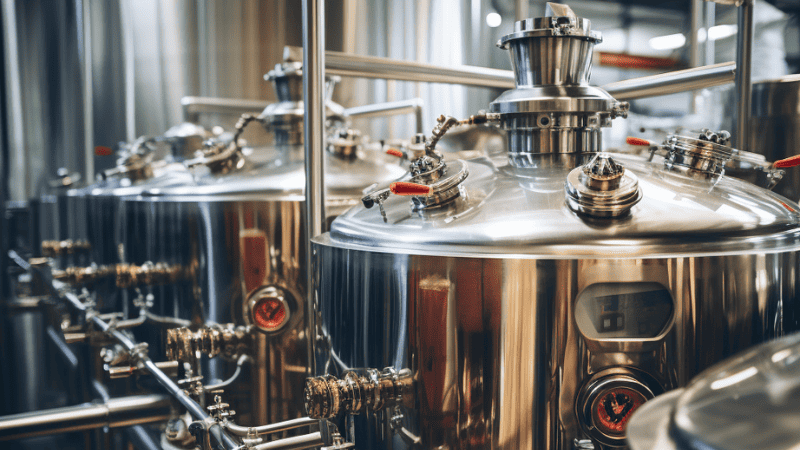According to a BBC report, the global craft beer market has seen exponential growth, driven by a discerning audience that values quality and authenticity. Central to this is the often-overlooked silicone O-ring. These tiny components ensure that every sip you take remains true to its intended flavor and character.
As we unravel the intricacies of rubber compounds in this article, we’ll explore their profound effects on taste, safety, and the undeniable emphasis on quality seals in the vast food and beverage industry. After all, as Forbes points out, with the growth and sophistication of the brewing industry, every element, including seals and O-rings, plays a crucial role in delivering that perfect brew.
Understanding O-rings in Brewing Equipment

When savoring that frothy pint of craft beer, have you ever pondered the intricate ballet of machinery and components that brought it to your hands? At the heart of this dance, silicone O-rings and rubber O-rings serve as the unsung heroes. Acting as seals in brewing equipment, they ensure no unwanted air or contaminants enter the system, keeping your brew pure and unadulterated. Think of them as the guardians of your beer’s integrity.
Now, let’s chat about the shelf life of these O-rings. Much like how a fine wine has an optimal drinking window, O-rings have a lifespan too. Over time, wear and tear, coupled with continuous exposure to brewing ingredients, can degrade their quality. A study published in the Journal of Brewing Science emphasized the correlation between the condition of equipment seals and the taste profile of beers. An aging O-ring might not offer the same airtight seal, subtly altering the brew’s taste over time.
So, next time you raise a toast, spare a thought for these little rubber wonders. Ensuring they’re in prime condition means every sip you take is as the brewmaster intended: authentic, flavorful, and just right.
The Role of Material Selection
Selecting the right material in brewing isn’t just a technical choice—it’s a decision that reverberates through every sip of beer. Just as a chef meticulously picks ingredients, brewers need to be discerning about the materials they use, especially when it comes to O-rings.

When it comes to FDA-compliant materials, the options are vast. However, silicone rubber materials hold a special place in the brewing industry. Silicone’s inherent properties, such as its flexibility, heat resistance, and non-reactivity, make it a preferred choice.
But the story doesn’t end with silicone. The brewing process, with its unique challenges, necessitates an exploration of various rubber formulations. For instance, while some beers have a more acidic profile, others might be brewed under high-temperature conditions. Each scenario calls for a different type of rubber. To start this off, we chose five of our common FDA-compliant materials to test into five different craft brews. FDA-compliant means that these elastomers are formulated using FDA whitelist ingredients, also known as 21 CFR 177.2600, which is a guideline for creating rubber articles for repeated use.
| Property/ Material | Nitrile | EPDM | Fluorocarbon | HCR Silicone | LSR |
|---|---|---|---|---|---|
| Chemical Resistance | Good (oils/solvents) | Excellent (ozone, water, acids) | Excellent (oils, fuels, acids) | Good (wide range) | Good (wide range) |
| Temperature Resistance | Up to 100°C | -50°C to 150°C | -20°C to 200°C | -60°C to 230°C | -55°C to 250°C |
| UV/Ozone Resistance | Poor | Excellent | Good | Good | Good |
| Mechanical Properties | Good | Good (flexibility) | Good | Good (flexibility) | Good (flexibility) |
| Cost | Relatively low | Moderate | High | Moderate to High | Moderate to High |
| Typical Uses | Oil seals, hoses | Weather seals, gaskets | High-temp seals, aerospace | Food-grade applications, gaskets | Medical, food-grade applications |
| Elongation | Moderate | High | Moderate | Very high | Very high |
| Potential Taste/Odor Impact | Possible with certain brews | Low likelihood | Possible with certain brews | Low likelihood | Low likelihood |
In essence, when we talk about brewing, material selection is more than just a technical discussion. It’s about ensuring that every glass of beer is as perfect as it was intended to be, and that begins with the right choice of O-ring material.
Take the First Step:
Requst for an Inquire
Quality Meets Affordability. Inquire Now for High-Quality Products at Low Volumes.
Potential Contaminants and How They Affect Your Brew
Imagine you’ve just poured a perfectly chilled beer into your glass. The color is golden, the froth inviting. You take a sip, expecting that familiar taste, but something’s off. Could it be the O-ring? Let’s dive into this often-overlooked aspect of brewing.

One of the concerns that brewers have is chemical leaching. Specific materials, especially particular types of rubber and seal materials, can release compounds over time. According to a detailed report by BBC, certain rubbers, when exposed to the acids in beer, can break down, releasing undesirable compounds. This is not just about taste; it’s about health. Unwanted chemicals in your drink are the last thing you’d want.
Now, let’s talk about taste and aroma. You might think, “It’s just a seal, how much can it affect the brew?” But remember, brewing is a delicate art, and even minor changes can alter the profile of a beer. Material interactions can lead to subtle shifts in taste and aroma. An experiment published in the Journal of Food Science showcased how different O-ring materials affected oxygen transmission, leading to discernible taste differences in the beer.
But it’s not just about flavor. Safety is paramount. This is where the importance of food-grade and sanitary gaskets comes into play. Using non-compliant materials can pose health risks. As highlighted by the FDA, the administration is stringent about materials that come in contact with food and beverages, and for a good reason.
| Material Type | Potential for Chemical Leaching | Impact on Taste and Aroma | Safety Concerns |
| Standard Rubber | High potential due to breakdown when exposed to acids. | Can lead to a more bitter or “off” taste. | Non-food-grade rubbers can pose health risks. |
| Silicone | Low potential as it is non-reactive. | Preserves the intended taste and aroma of the beer. | Generally safe; best to use food-grade silicone. |
| PTFE (Teflon) | Very low potential for leaching. | Minimal impact on taste and aroma. | Food-grade PTFE is safe, but non-food-grade can have contaminants. |
| Nitrile Rubber | Moderate potential, especially under high temperatures. | Can alter the beer’s taste if degraded. | Best to use food-grade nitrile rubber. |
In conclusion, the next time you savor a beer, remember there’s more to it than malt and hops. It’s also about the silent guardians – the O-rings and seals, ensuring every sip is safe, pure, and flavorful. Cheers to them!
Take the First Step:
Requst for an Inquire
Quality Meets Affordability. Inquire Now for High-Quality Products at Low Volumes.
Temperature Fluctuations and Pressure Changes:
Ah, the art and science of brewing! Just when you thought it was all about the perfect blend of malt and hops, along comes the technical aspect.
The brewing process is a meticulous dance of temperatures and pressures. And guess who’s at the forefront, ensuring everything runs seamlessly? The O-rings, particularly the tri-clamp gaskets. You see, these gaskets are designed to withstand the variable conditions of brewing, be it the cold chill of lagering or the steamy heat of boiling wort.

Now, imagine for a moment, your favorite stout being brewed. The temperature rises, and the pressure builds. How do the O-rings respond? According to an article from the Journal of the Institute of Brewing, tri-clamp gaskets expand or contract, experiencing phenomena known as volume swell and negative swell. This adaptability is essential to ensure that there are no leaks or breaches in the system.
But why should you care? Well, any inconsistency in this delicate balance can impact the brew’s consistency. Fluctuating temperatures and pressures can lead to potential equipment malfunctions, compromising the flavor and aroma of the beer. A BBC feature on the intricacies of brewing highlighted the importance of maintaining a stable environment to achieve that perfect brew.
So, next time you’re sipping on that amber ale or crisp pilsner, remember the unsung heroes: the O-rings and tri-clamp gaskets. They’ve weathered the storms of temperature and pressure, all to ensure your drink is just right. Cheers to the science behind the sip!
Maintenance and Care
Imagine nurturing a beautiful garden. You wouldn’t just plant the seeds and walk away, would you? Similarly, brewing equipment, with its intricate components like O-rings, demands attentive care. Let’s journey together through the world of maintaining these tiny yet essential parts.
When it comes to cleaning, it’s more than just a rinse and repeat. Ensuring the longevity of seals that affect your brew begins with proper cleaning methods. Utilizing mild detergents and soft brushes to clean O-rings is vital. Harsh chemicals can degrade the material, so gentle care is the mantra.

Now, just like you’d regularly check on those budding roses, O-rings too need regular checks and inspections. Over time, wear and tear or exposure to certain aggressive brews can compromise their integrity. Regular testing ensures they’re performing at their peak, maintaining the quality and consistency of the brews.
Lastly, there comes a time when our O-ring companions need to retire. When that moment arrives, it’s crucial to follow best practices for replacing and fitting new ones. Ensuring a proper fit and using quality materials will ensure the brewing process remains smooth and uninterrupted.
So, my fellow brewing aficionado, caring for our equipment is akin to tending to a garden. With patience, regular checks, and a touch of love, we ensure every pour is perfection in a glass. Here’s to the unsung heroes that make every sip worthwhile. Cheers!
Take the First Step:
Requst for an Inquire
Quality Meets Affordability. Inquire Now for High-Quality Products at Low Volumes.
Sourcing Quality O-rings for Optimal Brewing
In the brewing world, every ingredient and component plays its part. While the choice of hops or yeast garners much attention, the significance of the O-ring—a small but crucial component—cannot be overlooked. The pursuit of the ideal seal is as vital as selecting the finest grains.
A top-notch O-ring ensures a consistent brewing environment. The main criteria in choosing the right O-ring revolve around factors like achieving the lowest volume swell, which ensures the O-ring’s minimal expansion when exposed to liquids, guaranteeing an unbroken and snug seal during the brewing process.

Zooming into the beverage industry, the essence of craft beer and light-lager production lies in the meticulous details. It’s a domain where even the slightest alteration can affect the taste and aroma. In such a nuanced environment, the quality of seal materials becomes paramount.
A substandard O-ring could jeopardize the brew’s very soul. O-rings too have their lifespan. When the time comes for replacement, choose quality over convenience. Proper fitting and top-grade materials are essential to keep your brewing process seamless.
In conclusion, when diving deep into the art of brewing, let’s not forget the silent workhorses like O-rings. Their role might seem diminutive, but their impact is profound, ensuring that every brew is a masterpiece in its own right.
Conclusion
In essence, the intricacies of the brewing process are vast and varied, but the role of the O-ring stands paramount. Its influence on the taste and quality of beer, especially in the expansive brewing industry, is undeniable. For those keen on delving deeper into the world of brewing and the materials that make it exceptional, our comprehensive Brewing Guide awaits.
Ready to Elevate Your Brew with Hongju
Why leave your brew to mere chance? Reach out for expert advice and discover how Hongju‘s impeccable range of eco-friendly silicone and rubber products can be the game-changer for your brewing endeavors. We hope this exploration has enriched your understanding. Always remember, at Hongju, we’re committed to assisting you in making the finest O-rings for your brewing aspirations. Get Started Now!